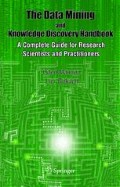Abstract
The aim of this contribution is to illustrate the role of statistical models and, more generally, of statistics, in choosing a Data Mining model. After a preliminary introduction on the distinction between Data Mining and statistics, we will focus on the issue of how to choose a Data Mining methodology. This well illustrates how statistical thinking can bring real added value to a Data Mining analysis, as otherwise it becomes rather difficult to make a reasoned choice. In the third part of the paper we will present, by means of a case study in credit risk management, how Data Mining and statistics can profitably interact.
Access this chapter
Tax calculation will be finalised at checkout
Purchases are for personal use only
Preview
Unable to display preview. Download preview PDF.
References
Akaike, H. A new look at statistical model identification. IEEE Transactions on Automatic Control 1974; 19: 716–723
Bernardo, J.M. and Smith, A.F.M., Bayesian Theory. New York: Wiley, 1994.
Bickel, P.J. and Doksum, K.A., Mathematical Statistics. New Jersey: Prentice and Hall, 1977.
Castelo, R. and Giudici, P., Improving Markov chain model search for Data Mining. Machine Learning, 50:127–158, 2003.
Giudici, P., Applied Data Mining. London: Wiley, 2003.
Giudici P., Castelo R.. Association models for web mining, Data mining and knowledge discovery, 5, 183–196, 2001.
Hand, D.J., Mannila, H. and Smyth, P., Principles of Data Mining. New York: MIT press, 2001.
Hand, D. Construction and assessment of classification rules. London: Wiley, 1997.
Hastie, T, Tibshirani, R., Friedman, J. The elements of statistical learning: Data Mining, inference and prediction. New York: Springer-Verlag, 2001.
Mood, A.M., Graybill, F.A. and Boes, D.C. Introduction to the theory of Statistics. Tokyo: McGraw Hill, 1991.
Schwarz, G. Estimating the dimension of a model. Annals of Statistics 1978; 62: 461–464.
Zucchini, W. An Introduction to Model Selection. Journal of Mathematical Psychology 2000; 44: 41–61
Author information
Authors and Affiliations
Editor information
Editors and Affiliations
Rights and permissions
Copyright information
© 2005 Springer Science+Business Media, Inc.
About this chapter
Cite this chapter
Giudici, P. (2005). Data Mining Model Comparison. In: Maimon, O., Rokach, L. (eds) Data Mining and Knowledge Discovery Handbook. Springer, Boston, MA. https://doi.org/10.1007/0-387-25465-X_31
Download citation
DOI: https://doi.org/10.1007/0-387-25465-X_31
Publisher Name: Springer, Boston, MA
Print ISBN: 978-0-387-24435-8
Online ISBN: 978-0-387-25465-4
eBook Packages: Computer ScienceComputer Science (R0)

